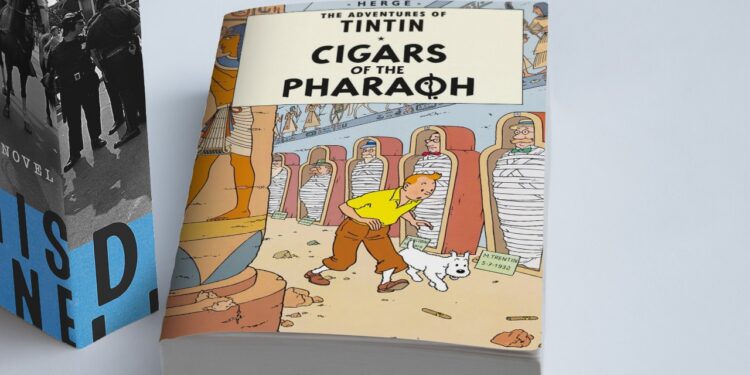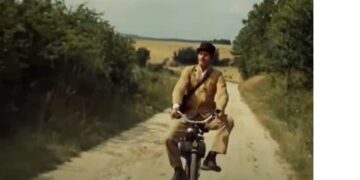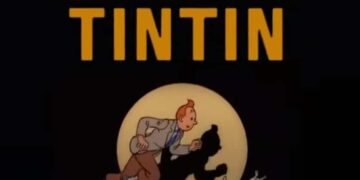Hergé, whose real name is Georges Prosper Remi, was a Belgian cartoonist and writer, widely regarded as one of the most important figures in the history of comics. Born on May 22, 1907, in Etterbeek, Brussels, Hergé’s passion for drawing and storytelling emerged at a young age. His iconic creation, Tintin, has become a beloved character around the world. Hergé’s unique artistic style, vivid storytelling, and attention to detail set him apart from his contemporaries. His influence extends beyond the world of comics, with his work inspiring generations of artists, filmmakers, and writers.
Hergé’s Biography: From Humble Beginnings to International Fame
Hergé’s journey to international fame began from humble beginnings. As a child, he showed a talent for drawing and enrolled in the Saint-Boniface School of Applied Arts. After completing his studies, he joined the newspaper Le Vingtií¨me Sií¨cle, where he worked as an illustrator and cartoonist. It was during his time at Le Vingtií¨me Sií¨cle that Hergé created his most famous character, Tintin.
Tintin made his debut in 1929 in the comic strip “Tintin in the Land of the Soviets.” The character quickly gained popularity, and Hergé continued to create more adventures for him. Over the course of his career, Hergé wrote and illustrated 23 Tintin adventures, each one taking readers to fascinating locations around the world.
Hergé’s Journey in the World of Comics: The Creation of Tintin and his Adventures
Tintin is undoubtedly Hergé’s most significant contribution to the world of comics. The character, with his iconic quiff and faithful dog, Snowy, captured the imagination of readers young and old. Hergé’s meticulous attention to detail and his ability to create engaging storylines made Tintin a global phenomenon.
Some of the most memorable Tintin adventures include “The Secret of the Unicorn,” “Explorers on the Moon,” and “The Calculus Affair.” In these stories, Tintin, along with his loyal companions Captain Haddock and Professor Calculus, embarks on thrilling quests filled with danger, intrigue, and humor. Hergé’s ability to transport readers to different parts of the world, from the deserts of Egypt to the depths of the ocean, is a testament to his storytelling prowess.
Hergé’s Impact on Cinema: The Screen Adaptation of Tintin et le temple du soleil
Hergé’s influence extends beyond the world of comics and into the realm of cinema. In 2011, director Steven Spielberg brought Tintin to the big screen with the animated film “The Adventures of Tintin: The Secret of the Unicorn.” The film combined elements from three of Hergé’s comics, including “The Secret of the Unicorn,” “Red Rackham’s Treasure,” and “The Crab with the Golden Claws.”
“The Adventures of Tintin” received critical acclaim for its faithful adaptation of Hergé’s work and its stunning animation. The film perfectly captured the spirit of Tintin’s adventures and introduced the beloved character to a new generation of fans. Hergé’s legacy lives on through the continued popularity of Tintin and the success of the film adaptation.
Intriguing Tidbits: Uncovering Lesser-Known Aspects of Hergé’s Life and Career
While Hergé’s life and career are widely celebrated, there are also lesser-known aspects that add depth to his story. For instance, Hergé’s love life and friendships played a significant role in shaping his work. He had a tumultuous love life, with multiple relationships and marriages throughout his life. These personal experiences often found their way into his comics, adding a layer of complexity to his storytelling.
Additionally, Hergé experienced financial highs and lows throughout his career. At times, he was incredibly wealthy, but he also faced periods of financial struggle. Despite these challenges, Hergé’s dedication to his craft never wavered, and he continued to create captivating stories that resonated with readers.
Hergé’s Best Quotes: Insightful Words from the Master of Comics
Hergé was not only a talented artist but also a wise and insightful individual. Some of his best quotes offer a glimpse into his creative process and philosophy. One of his notable quotes is, “I love to draw, and the adventure of Tintin allows me to live through my drawings.” This quote highlights Hergé’s deep passion for his work and his belief in the power of storytelling.
Another memorable quote from Hergé is, “I have always tried to give my best, even when the circumstances were not ideal.” This quote reflects Hergé’s commitment to his craft and his determination to overcome any obstacles that came his way. These quotes, and many others, showcase Hergé’s talent and the enduring impact of his work.
Exploring the World through Hergé’s Comics: Main Places where Tintin’s Adventures Are Set
One of the remarkable aspects of Hergé’s comics is the diverse range of locations in which Tintin’s adventures take place. From the bustling streets of Brussels to the exotic landscapes of South America, Hergé skillfully transports readers to different parts of the world. Some of the main places where Tintin’s adventures are set include:
- Egypt: In “Cigars of the Pharaoh” and “The Blue Lotus,” Tintin uncovers ancient mysteries and confronts dangerous villains in the land of the pharaohs.
- The Moon: In “Explorers on the Moon,” Tintin and his companions embark on a groundbreaking mission to explore the lunar surface.
- Tibet: “Tintin in Tibet” takes readers on a breathtaking journey through the Himalayas as Tintin searches for his friend, Chang.
- The Amazon Rainforest: In “The Seven Crystal Balls” and “Prisoners of the Sun,” Tintin delves into the mysteries of the Amazon, encountering ancient civilizations and treacherous adversaries.
- The Arctic: “The Shooting Star” and “The Red Sea Sharks” bring Tintin to the icy landscapes of the Arctic, where he confronts pirates and uncovers hidden treasures.
These are just a few examples of the many fascinating locations that Hergé’s comics explore, showcasing his ability to capture the essence of different cultures and environments.
The Evolution of Hergé’s Comics: From the First Comic to the Last
Hergé’s career spanned several decades, and his comics underwent significant evolution over time. The first-ever Tintin comic, “Tintin in the Land of the Soviets,” was published in 1929 and introduced readers to the intrepid reporter and his faithful companion, Snowy. This early comic laid the foundation for the adventures to come and showcased Hergé’s distinctive artistic style.
As Hergé continued to develop as an artist, his storytelling and drawing techniques evolved. He experimented with different artistic styles and storytelling approaches, pushing the boundaries of the medium. The final Tintin adventure, “Tintin and the Picaros,” was published in 1976, marking the end of an era. Throughout his career, Hergé’s dedication to his craft and his commitment to creating engaging stories remained constant.
Other Artists who Inspired Hergé: Discovering the Influences on his Work
Hergé’s work was undoubtedly groundbreaking and innovative, but he was also influenced by other artists and creators. One of the key influences on Hergé’s artistic style was the Belgian painter and cartoonist, Jijé. Hergé admired Jijé’s ability to create expressive characters and dynamic compositions, and he incorporated some of these elements into his own work.
Another significant influence on Hergé was the American comic strip “The Katzenjammer Kids.” Hergé admired the strip’s humor and storytelling, and it inspired him to incorporate more humor into his own comics. These are just a few examples of the many artists who inspired Hergé, highlighting his willingness to learn from others and push the boundaries of his own creativity.
Must-Read Writers and Comics for Hergé Fans: Recommendations for Further Exploration
If you’re a fan of Hergé’s work, there are several other writers and comics that you should explore. Here are five recommendations to get you started:
- “Asterix” by René Goscinny and Albert Uderzo: This beloved comic series follows the adventures of Asterix, a Gaulish warrior, and his friend Obelix. The series combines historical settings with humor and adventure.
- “Calvin and Hobbes” by Bill Watterson: This iconic comic strip follows the imaginative adventures of Calvin, a young boy, and his stuffed tiger, Hobbes. The strip is known for its insightful observations and whimsical storytelling.
- “Maus” by Art Spiegelman: This graphic novel tells the harrowing story of Art Spiegelman’s father’s experiences during the Holocaust. The book explores themes of memory, trauma, and the power of storytelling.
- “Bone” by Jeff Smith: This epic fantasy series follows the adventures of three cousins, Fone Bone, Phoney Bone, and Smiley Bone, as they navigate a mysterious land filled with dragons and other fantastical creatures.
- “Watchmen” by Alan Moore and Dave Gibbons: This groundbreaking graphic novel deconstructs the superhero genre and explores complex themes of power, morality, and the nature of humanity.
These comics offer a diverse range of storytelling styles and genres, showcasing the breadth and depth of the medium.
Buying Guide and Gift Ideas for Hergé Lovers: Finding the Perfect Collectibles and Memorabilia
If you’re a die-hard Hergé fan or know someone who is, there are plenty of collectibles and memorabilia available to celebrate his work. Here are some gift ideas and buying guide recommendations:
- Tintin Books: Complete your collection of Tintin adventures with the beautifully illustrated hardcover editions.
- Tintin Merchandise: From T-shirts to mugs, there is a wide range of Tintin-themed merchandise available, perfect for showing off your love for the iconic character.
- Art Prints: Bring Hergé’s stunning artwork into your home with high-quality art prints featuring scenes from his comics.
- Collectible Figurines: Add to your display with meticulously crafted figurines of Tintin, Captain Haddock, and other beloved characters.
- Limited Edition Box Sets: For the ultimate fan, limited edition box sets containing exclusive content and artwork are a must-have.
These are just a few examples of the many ways you can celebrate Hergé’s work and show your appreciation for his contribution to the world of comics.
Conclusion: Hergé’s Enduring Legacy in the World of Comics and Beyond
Hergé’s impact on the world of comics and storytelling is immeasurable. His creation, Tintin, has become an iconic character loved by millions around the world. Hergé’s attention to detail, engaging storytelling, and ability to capture the essence of different cultures and environments set him apart as a master of his craft.
Beyond the world of comics, Hergé’s work has inspired filmmakers, artists, and writers, leaving a lasting legacy. His comics continue to captivate readers of all ages, transporting them to new and exciting worlds. Hergé’s enduring legacy is a testament to his talent, creativity, and the timeless appeal of his characters and stories.










